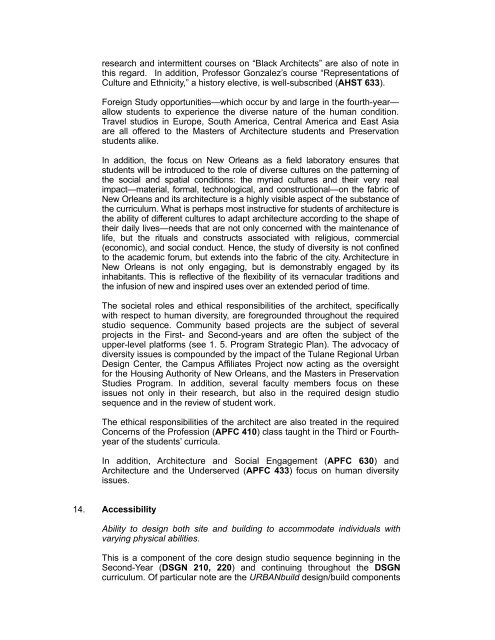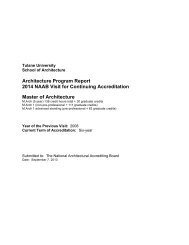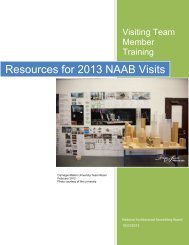Architecture Program Report Tulane University New Orleans ...
Architecture Program Report Tulane University New Orleans ...
Architecture Program Report Tulane University New Orleans ...
You also want an ePaper? Increase the reach of your titles
YUMPU automatically turns print PDFs into web optimized ePapers that Google loves.
esearch and intermittent courses on “Black Architects” are also of note in<br />
this regard. In addition, Professor Gonzalez’s course “Representations of<br />
Culture and Ethnicity,” a history elective, is well-subscribed (AHST 633).<br />
Foreign Study opportunities—which occur by and large in the fourth-year—<br />
allow students to experience the diverse nature of the human condition.<br />
Travel studios in Europe, South America, Central America and East Asia<br />
are all offered to the Masters of <strong>Architecture</strong> students and Preservation<br />
students alike.<br />
In addition, the focus on <strong>New</strong> <strong>Orleans</strong> as a field laboratory ensures that<br />
students will be introduced to the role of diverse cultures on the patterning of<br />
the social and spatial conditions: the myriad cultures and their very real<br />
impact—material, formal, technological, and constructional—on the fabric of<br />
<strong>New</strong> <strong>Orleans</strong> and its architecture is a highly visible aspect of the substance of<br />
the curriculum. What is perhaps most instructive for students of architecture is<br />
the ability of different cultures to adapt architecture according to the shape of<br />
their daily lives—needs that are not only concerned with the maintenance of<br />
life, but the rituals and constructs associated with religious, commercial<br />
(economic), and social conduct. Hence, the study of diversity is not confined<br />
to the academic forum, but extends into the fabric of the city. <strong>Architecture</strong> in<br />
<strong>New</strong> <strong>Orleans</strong> is not only engaging, but is demonstrably engaged by its<br />
inhabitants. This is reflective of the flexibility of its vernacular traditions and<br />
the infusion of new and inspired uses over an extended period of time.<br />
The societal roles and ethical responsibilities of the architect, specifically<br />
with respect to human diversity, are foregrounded throughout the required<br />
studio sequence. Community based projects are the subject of several<br />
projects in the First- and Second-years and are often the subject of the<br />
upper-level platforms (see 1. 5. <strong>Program</strong> Strategic Plan). The advocacy of<br />
diversity issues is compounded by the impact of the <strong>Tulane</strong> Regional Urban<br />
Design Center, the Campus Affiliates Project now acting as the oversight<br />
for the Housing Authority of <strong>New</strong> <strong>Orleans</strong>, and the Masters in Preservation<br />
Studies <strong>Program</strong>. In addition, several faculty members focus on these<br />
issues not only in their research, but also in the required design studio<br />
sequence and in the review of student work.<br />
The ethical responsibilities of the architect are also treated in the required<br />
Concerns of the Profession (APFC 410) class taught in the Third or Fourthyear<br />
of the students’ curricula.<br />
In addition, <strong>Architecture</strong> and Social Engagement (APFC 630) and<br />
<strong>Architecture</strong> and the Underserved (APFC 433) focus on human diversity<br />
issues.<br />
14. Accessibility<br />
Ability to design both site and building to accommodate individuals with<br />
varying physical abilities.<br />
This is a component of the core design studio sequence beginning in the<br />
Second-Year (DSGN 210, 220) and continuing throughout the DSGN<br />
curriculum. Of particular note are the URBANbuild design/build components














